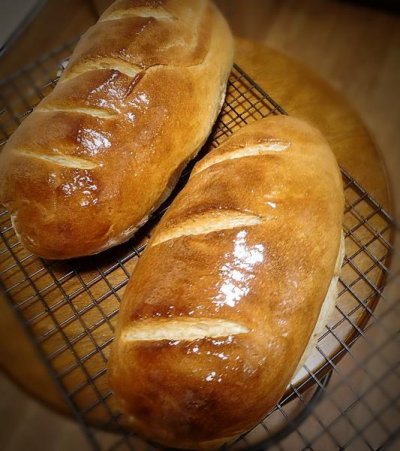Back ‘14, Mark got me a Kitchenaid professional 500 stand mixer for my birthday. I remember wanting one, but I can’t remember why I wanted one. I had never baked a loaf of bread, and my cake and cookie baking skills were (and still are, with a few exceptions) sorely lacking.
When we moved here in ‘15, the stand mixer kind of got buried amidst other unpacked boxes. When I started exploring the world of bread, I wanted it back in my life and in my kitchen. Buying a replacement, like one does sometimes when something gets misplaced, was out of the question because of the price, so I decided to get a bread maker. I was very happy with it, as it was inexpensive and turned out to be a good choice for a newbie baker. In fact, I’m still quite happy with it, although I rarely use any of its cycles besides “mix” and “dough” anymore.
Yesterday, we finally started unpacking some boxes that had been neglected for 2 years (that’s a whole ‘nuther story, so don’t start in on me), and lo and behold! There was my stand mixer with the grandiose name, all silver (gray?) and looking brand new (which it basically is). I haven’t found the beater or whisk attachments yet, but the dough hook was packed in the mixer’s bowl, yea! As I read up on it, my trepidation’s grew. While using a stand mixer appears to offer a lot more control over the dough, it seems that using one to make bread will necessitate changing my technique quite a bit to get that control.
I know that was a really long lead-up to what I want your advice on, my apologies. What can all of you master bakers tell me about using a stand mixer versus my happy little bread maker? What changes will I have to make in my now developed techniques, and in my thinking? And please let me know what your preferences are! I know many bakers prefer to do it all by hand, which is an attractive thought, but out of the question for me because of the arthritis in my hands, and while no-knead breads are currently all the rage (I’ve had a good deal of success with that method), the no-knead method definitely lends itself better to some types of bread than others. I’m sure these questions have come up many times in the threads of this fine forum, but it would be a great pleasure for me if we could reopen the discussion, if only because I like the interaction with real, live people!
So, friends, in the immortal words of Joan Rivers, can we talk?
When we moved here in ‘15, the stand mixer kind of got buried amidst other unpacked boxes. When I started exploring the world of bread, I wanted it back in my life and in my kitchen. Buying a replacement, like one does sometimes when something gets misplaced, was out of the question because of the price, so I decided to get a bread maker. I was very happy with it, as it was inexpensive and turned out to be a good choice for a newbie baker. In fact, I’m still quite happy with it, although I rarely use any of its cycles besides “mix” and “dough” anymore.
Yesterday, we finally started unpacking some boxes that had been neglected for 2 years (that’s a whole ‘nuther story, so don’t start in on me), and lo and behold! There was my stand mixer with the grandiose name, all silver (gray?) and looking brand new (which it basically is). I haven’t found the beater or whisk attachments yet, but the dough hook was packed in the mixer’s bowl, yea! As I read up on it, my trepidation’s grew. While using a stand mixer appears to offer a lot more control over the dough, it seems that using one to make bread will necessitate changing my technique quite a bit to get that control.
I know that was a really long lead-up to what I want your advice on, my apologies. What can all of you master bakers tell me about using a stand mixer versus my happy little bread maker? What changes will I have to make in my now developed techniques, and in my thinking? And please let me know what your preferences are! I know many bakers prefer to do it all by hand, which is an attractive thought, but out of the question for me because of the arthritis in my hands, and while no-knead breads are currently all the rage (I’ve had a good deal of success with that method), the no-knead method definitely lends itself better to some types of bread than others. I’m sure these questions have come up many times in the threads of this fine forum, but it would be a great pleasure for me if we could reopen the discussion, if only because I like the interaction with real, live people!
So, friends, in the immortal words of Joan Rivers, can we talk?
Last edited:

